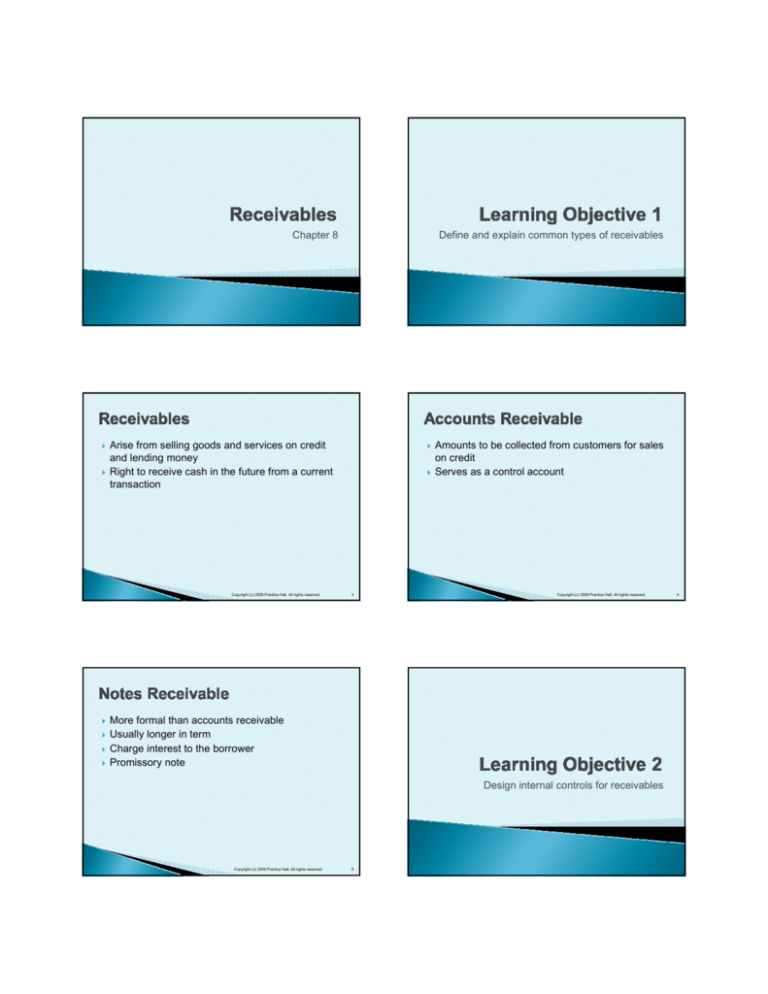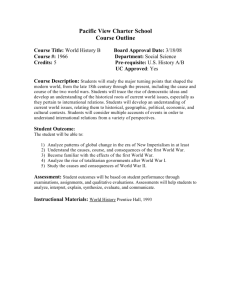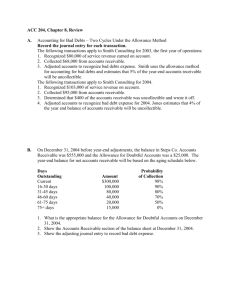
Chapter 8
Arise from selling goods and services on credit
and lending money
Right to receive cash in the future from a current
transaction
Copyright (c) 2009 Prentice Hall. All rights reserved.
Define and explain common types of receivables
3
Amounts to be collected from customers for sales
on credit
Serves as a control account
Copyright (c) 2009 Prentice Hall. All rights reserved.
More formal than accounts receivable
Usually longer in term
Charge interest to the borrower
Promissory note
Design internal controls for receivables
Copyright (c) 2009 Prentice Hall. All rights reserved.
5
4
Credit department evaluates customers’
applications
Separation of duties
Selling on credit
Two methods to account for uncollectible accounts
◦ Allowance method
◦ Direct write-off method
Copyright (c) 2009 Prentice Hall. All rights reserved.
7
Copyright (c) 2009 Prentice Hall. All rights reserved.
8
Based on the matching principle
Offset to expense is Allowance for uncollectible
accounts
Use the allowance method to account for
uncollectibles
Copyright (c) 2009 Prentice Hall. All rights reserved.
Percent of Sales
◦ Income Statement
Approach
10
Aging of Accounts
Receivable
GENERAL JOURNAL
◦ Balance Sheet
Approach
DATE
DESCRIPTION
REF
DEBIT
CREDIT
Uncollectible accounts expense
Allowance for uncollectible
accounts
To estimate bad debts for period
Copyright (c) 2009 Prentice Hall. All rights reserved.
11
Copyright (c) 2009 Prentice Hall. All rights reserved.
12
Adjust Allowance for
uncollectible accounts to
%
uncollectible
Credit sales
Aging Schedule
What is uncollectible accounts
expense?
?
Copyright (c) 2009 Prentice Hall. All rights reserved.
13
Copyright (c) 2009 Prentice Hall. All rights reserved.
14
GENERAL JOURNAL
DATE
DESCRIPTION
REF
DEBIT
Dec 31 Uncollectible account expense
CREDIT
Allowance for uncollectible accounts
210
Allowance for uncollectible accounts
210
$1,700
0-60 Days
Over 60 days
$71,000
$6,000
x 1%
x 20%
$710
Total
$ 210
$77,000
$1,200
$1,910
Allowance for uncollectible accts
$1,700
Adjustment needed
$210
$1,910
Copyright (c) 2009 Prentice Hall. All rights reserved.
15
When a specific customer account is identified as
uncollectible, it is written off
Copyright (c) 2009 Prentice Hall. All rights reserved.
16
Sometimes a customer will pay the amount owed
after the customer’s account is written off
Two entries needed
GENERAL JOURNAL
DATE
DESCRIPTION
REF
DEBIT
CREDIT
GENERAL JOURNAL
Allowance for uncollectible accounts
DATE
Accounts receivable-name
DESCRIPTION
REF
DEBIT
CREDIT
Accounts receivable-name
Allowance for uncoll. accounts
Cash
Accounts receivable-name
Copyright (c) 2009 Prentice Hall. All rights reserved.
17
Copyright (c) 2009 Prentice Hall. All rights reserved.
18
Increases (debits)
Sales on credit
Decreases (credits)
Customer payments
Write-offs
Decreases (debits)
Write-offs
Copyright (c) 2009 Prentice Hall. All rights reserved.
Increases (credits)
Uncollectible account
expense entry
Recoveries of
accounts previously
written off
19
Copyright (c) 2009 Prentice Hall. All rights reserved.
20
Used by small businesses
No Allowance for uncollectible accounts
Records Uncollectible accounts expense when
specific account is written off
GENERAL JOURNAL
Understand the direct write-off method for
uncollectibles
DATE
REF
DESCRIPTION
DEBIT
CREDIT
Uncollectible account expense
Accounts receivable-name
Write off account using direct write off
method
Copyright (c) 2009 Prentice Hall. All rights reserved.
Overstates Accounts receivable on the balance
sheet
Violates matching principle
Report receivables on the balance sheet
Copyright (c) 2009 Prentice Hall. All rights reserved.
23
22
Current asset
Shown net of Allowance for uncollectible accounts
Two presentation styles:
Balance Sheet (Partial)
December 31, 2012
Assets
Current assets:
Accounts receivable
Less: Allowance for uncollectible accounts
Accounts receivable, net
Journalize credit-card, bank card, and debit-card
sales
$$$$$
($$$$)
$$$$$
Balance Sheet (Partial)
December 31, 2012
Assets
Current assets:
Accounts receivable, net of allowance for doubtful accounts of $$$
$$$$$
Copyright (c) 2009 Prentice Hall. All rights reserved.
25
Credit card companies (American Express and
Discover) pay the retailer and bill the customer
Retailers receive cash at time of sale
VISA and MasterCard most common bank cards
GENERAL JOURNAL
DATE
DESCRIPTION
GENERAL JOURNAL
REF
DEBIT
CREDIT
REF
Cash
Credit card discount expense
Bank card discount expense
DEBIT
CREDIT
Sales revenue
Copyright (c) 2009 Prentice Hall. All rights reserved.
DESCRIPTION
Accounts receivable – Discover
Sales revenue
DATE
27
Copyright (c) 2009 Prentice Hall. All rights reserved.
Different than credit and bank cards
Same as cash
Account for notes receivable
Copyright (c) 2009 Prentice Hall. All rights reserved.
29
28
Interest
starts
More formal than Accounts receivable
Debtor signs promissory note
PROMISSORY
PROMISSORYNOTE
NOTE
Oct. 4, 2010
$10,000.00
______________
_____________
______________
_____________
Amount
Date
Amount
Date
For
value
Principal
For
valuereceived,
received,I Ipromise
promiseto
topay
payto
tothe
theorder
orderof
ofFirst
FirstNational
NationalBank
Bank
Ten
thousand and no/100---------------------Dollars
__________________________________
__________________________________
Dollars
Payee
January 2, 2011
on
on______________________________
______________________________
plus
plusinterest
interestat
atthe
theannual
annualrate
rateof
of12%.
12%.
Maturity
Date
Copyright (c) 2009 Prentice Hall. All rights reserved.
Maker
________________________
________________________
Interest
Jeanette Sims
Rate
31
Copyright (c) 2009 Prentice Hall. All rights reserved.
32
A 90-day note issued March 13
Maturity date can be:
◦ A specific date such as March 13
◦ Stated in terms of number of months
◦ Stated in terms of number of days
Days in note
90
Days in March
31
Date of issue
-13
Days outstanding in March
-18
Days remaining
30
Days in May
31
Due date in June
Copyright (c) 2009 Prentice Hall. All rights reserved.
33
35
-61
11
Copyright (c) 2009 Prentice Hall. All rights reserved.
Copyright (c) 2009 Prentice Hall. All rights reserved.
72
Days in April
34
If any notes receivable are outstanding at the end
of the period, interest must be accrued
Interest is earned over time
Revenue must be recorded in the period earned
Copyright (c) 2009 Prentice Hall. All rights reserved.
36
Note term = 9 months
GENERAL JOURNAL
DATE
4 months
5 months
Date of Note,
Aug 1, 2011
2011
Jan 3
End of Fiscal Year,
Dec 31, 2011
Maturity Date,
May 1, 2012
Oct
1
Dec
Copyright (c) 2009 Prentice Hall. All rights reserved.
DESCRIPTION
DEBIT
CREDIT
2012
Oct 1 Cash
Interest receivable
Interest revenue
Notes receivable
26,400
600
1,800
24,000
DEBIT
CREDIT
101,920
2,080
104,000
24,000
24,000
Interest receivable
Interest revenue
(24,000 x 10% x 3/12)
600
600
Copyright (c) 2009 Prentice Hall. All rights reserved.
REF
REF
Cash
Bank card discount expense
Sales revenue
Notes receivable
Cash
37
GENERAL JOURNAL
DATE
31
DESCRIPTION
38
If the maker does not pay the note on the due
date, the note is dishonored
The note is expired, but the maker still owes the
company for the maturity value
An entry is made to convert the note into an
account receivable
GENERAL JOURNAL
DATE
DESCRIPTION
REF
DEBIT
CREDIT
Accounts receivable-name
Notes receivable-name
Interest revenue
Copyright (c) 2009 Prentice Hall. All rights reserved.
39
Copyright (c) 2009 Prentice Hall. All rights reserved.
40
Also called the “quick ratio”
Measures entity’s ability to pay its current liabilities
immediately
Use the acid-test ratio and days’ sales in
receivables to evaluate a company
Copyright (c) 2009 Prentice Hall. All rights reserved.
42
Also called “collection period”
Indicates the number of days it takes to collect the
average balance of receivables
One day’s sales = Net sales ÷ 365 days
Days’ sales in average accounts receivable =
Average net accounts receivable ÷ One day’s sales
Copyright (c) 2009 Prentice Hall. All rights reserved.
43
Copyright (c) 2009 Prentice Hall. All rights reserved.
44








